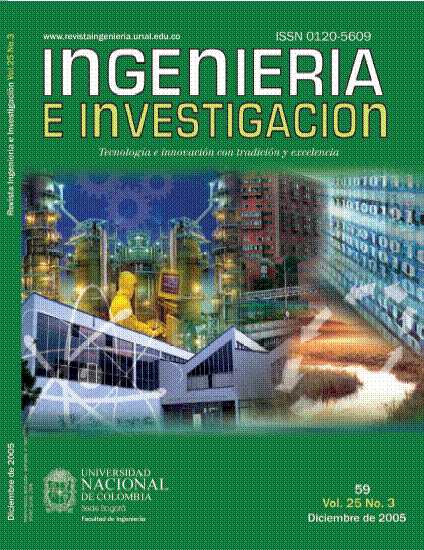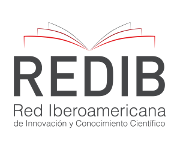Geotechnical information as an important element when planning and designing civil engineering work Bogota
Información geotécnica como elemento de análisis en la planeación y diseño de obras civiles en Bogotá
DOI:
https://doi.org/10.15446/ing.investig.v25n3.14673Keywords:
geostatistics, geotechniques, soil moisture content, spatial autocorrelation, kriging, experimental semivariogram, time of year (en)geoestadística, geotecnia, humedad del suelo, autocorrelación espacial, kriging, semivariograma experimental, estacionariedad (es)
Downloads
The city of Bogota provides a dynamic scenario re civil construction work; it is thereby essential to have relevant information available for the suitable planning and evaluation of engineering work from both the structural and budgetary points of view. The moisture content of soil has become a most important variable, given its great impact on placing structures in Bogota. This is why this work on city zoning aimed at orientating planning and designing civil engineering work has been done according to the percentage of moisture in soil. Information from 43,000 initial samples was used for geostatistical analysis to predict soil moisture content through the whole area.
Four ranges of depth were used for establishing this variable's correlation with other physical variables. Factors were identified which led to understanding results regarding soil moisture content and its behavior in the area being studied. Areas were found having high percentages of moisture content in soil in the northeast of Bogotá and less moist areas in the soil towards the southeast and the east of Bogotá (Bogota’s eastern heights). Different behavior was found for moisture content at depths greater than 6 meters.
La ciudad de Bogotá constituye un escenario de gran dinamismo en cuanto a la construcción de obras civiles se refiere, y es fundamental contar con información relevante para una adecuada planeación y evaluación de las obras, tanto desde el punto de vista estructural como presupuestal. La humedad del suelo se convierte en una variable de gran interés dada su alta incidencia en el fenómeno de asentamientos de las estructuras en Bogotá, razón por la cual se abordó en este trabajo la zonificación de la ciudad de acuerdo al porcentaje de humedad del suelo, como instrumento de análisis para orientar la planeación y diseño de obras de ingeniería civil. Mediante técnicas de análisis geoestadístico se usó la información de 43.000 muestras iniciales, para hacer la predicción de la humedad en todo el territorio a cuatro rangos de profundidad y establecer la correlación de esta variable con otras variables físicas, encontrando resultados que constituyen un insumo para el análisis propuesto. Adicionalmente, se identificaron los factores que permiten explicar y entender los resultados encontrados en relación con la humedad, haciendo posible la comprensión del comportamiento de la misma en el área de estudio. En esencia, se encontró la predominancia de zonas con altos porcentajes de humedad del suelo al noroeste de Bogotá, y zonas de menor humedad del suelo hacia el sureste y el oriente cerros orientales. Finalmente, se encontró un comportamiento diferente de la variable humedad después de seis metros de profundidad.
References
Bosque Sendra, J. Sistemas de información geográfica. Ediciones Rialp, pp. 191, 195, España, 1992.
Casas, H.; Moreno Z. Y Rodríguez, L. "Zonificación geotécnica por compresibilidad del sector norte de Santa Fe de Bogotá," trabajo de grado para ingeniería civil, Universidad Nacional de Colombia, Bogotá, 1997.
Chang, Kang-tsung, Geographic Information Systems, McGraw-Hill Higher Education, EE.UU. pp 256, 255 y 257. 2002.
Cressie, Noel. Geostatistics: A Tool for Environmental Modelers. Environmental Modeling with GIS, Capítulo 41, Oxford University Press, 1993.
David, J, "El subsuelo de Bogotá, zonificación y propuesta de investigación", proyecto de grado, Universidad de los Andes, Bogotá, febrero de 1990.
Jiménez Salas, J.A. y De Justo Alpañes, Geotecnia y cimientos, Tomo I, Propiedades de los suelos y las Rocas, segunda edición, 1980.
Ingeominas, "Zonificación geotécnica del Distrito Especial de Bogotá", Convenio N° 200-86 con el Departamento Administrativo de Planeación del Distrito Especial de Bogotá, 1988.
Giraldo, H., Ramón, "Introducción a la geoestadística", Simposio de Estadística, 2002.
Maneta, M. y Schnabel, S, "Aplicación de redes neuronales artificiales para determinar la distribución espacial de la humedad del suelo en una pequeña cuenca de drenaje". Grupo de Investigación Geoambiental del Departamento de Geografía de la Universidad de Extremadura, España, 2003. http://www.zonanosaturada.com/publics/V6/p295-304.pdf
Matheron, G., "La Thóorie des Variables Regionalisées et ses Applications", Les Cahiers du Centre de Morphologie Mathematique de Fontainebleau, Fascicule 5, Ecole de Mines de Paris, 212 pp. 1970.
Moral García, F y Marques Da Silva, J., "Ejemplo de una representación gráfica de una variable regionalizada", XIV Congreso Internacional de Ingeniería Gráfica, España, 2002.
Salamanca, Gabriel., "Microzonificación del Área II P de Santa Fe de Bogotá, tesis de grado para el magíster en geotecnia, Universidad Nacional de Colombia, Bogotá, 1995.
Samper, F. Javier y Carrera, Jesús, Geoestadística, aplicaciones a la hidrogeología, segunda edición, Centro Internacional de Métodos Numéricos en Ingeniería, España, 1996.
Sotelo, Rubén., "Fotointerpretación y procesamiento digital de imágenes, en la caracterización geotécnica del suelo para usos ingenieriles, Centro de Geociencias Aplicadas - Facultad de Ingeniería, Argentina, 2003, http://www1.unne.edu.ar/cyt/2003/comunicaciones/07Tecnologicas/T-023.pdf
Silva Medina, Gustavo A., Hidrología básica, Universidad Nacional de Colombia, Facultad de Ingeniería I, "Propiedades de los suelos y las rocas", segunda edición, 1998.
How to Cite
APA
ACM
ACS
ABNT
Chicago
Harvard
IEEE
MLA
Turabian
Vancouver
Download Citation
CrossRef Cited-by
Dimensions
PlumX
Article abstract page views
Downloads
License
Copyright (c) 2005 Denisse Cangrejo Aljure, Carlos Gustavo Infante

This work is licensed under a Creative Commons Attribution 4.0 International License.
The authors or holders of the copyright for each article hereby confer exclusive, limited and free authorization on the Universidad Nacional de Colombia's journal Ingeniería e Investigación concerning the aforementioned article which, once it has been evaluated and approved, will be submitted for publication, in line with the following items:
1. The version which has been corrected according to the evaluators' suggestions will be remitted and it will be made clear whether the aforementioned article is an unedited document regarding which the rights to be authorized are held and total responsibility will be assumed by the authors for the content of the work being submitted to Ingeniería e Investigación, the Universidad Nacional de Colombia and third-parties;
2. The authorization conferred on the journal will come into force from the date on which it is included in the respective volume and issue of Ingeniería e Investigación in the Open Journal Systems and on the journal's main page (https://revistas.unal.edu.co/index.php/ingeinv), as well as in different databases and indices in which the publication is indexed;
3. The authors authorize the Universidad Nacional de Colombia's journal Ingeniería e Investigación to publish the document in whatever required format (printed, digital, electronic or whatsoever known or yet to be discovered form) and authorize Ingeniería e Investigación to include the work in any indices and/or search engines deemed necessary for promoting its diffusion;
4. The authors accept that such authorization is given free of charge and they, therefore, waive any right to receive remuneration from the publication, distribution, public communication and any use whatsoever referred to in the terms of this authorization.




























